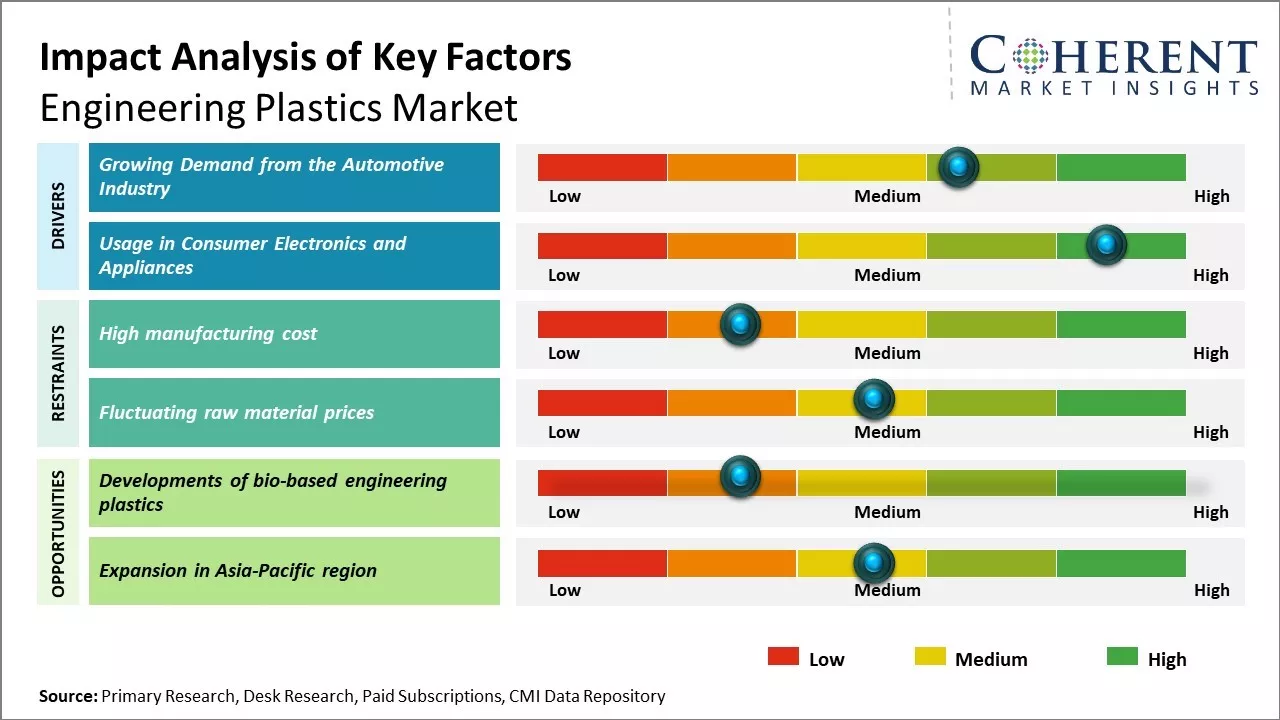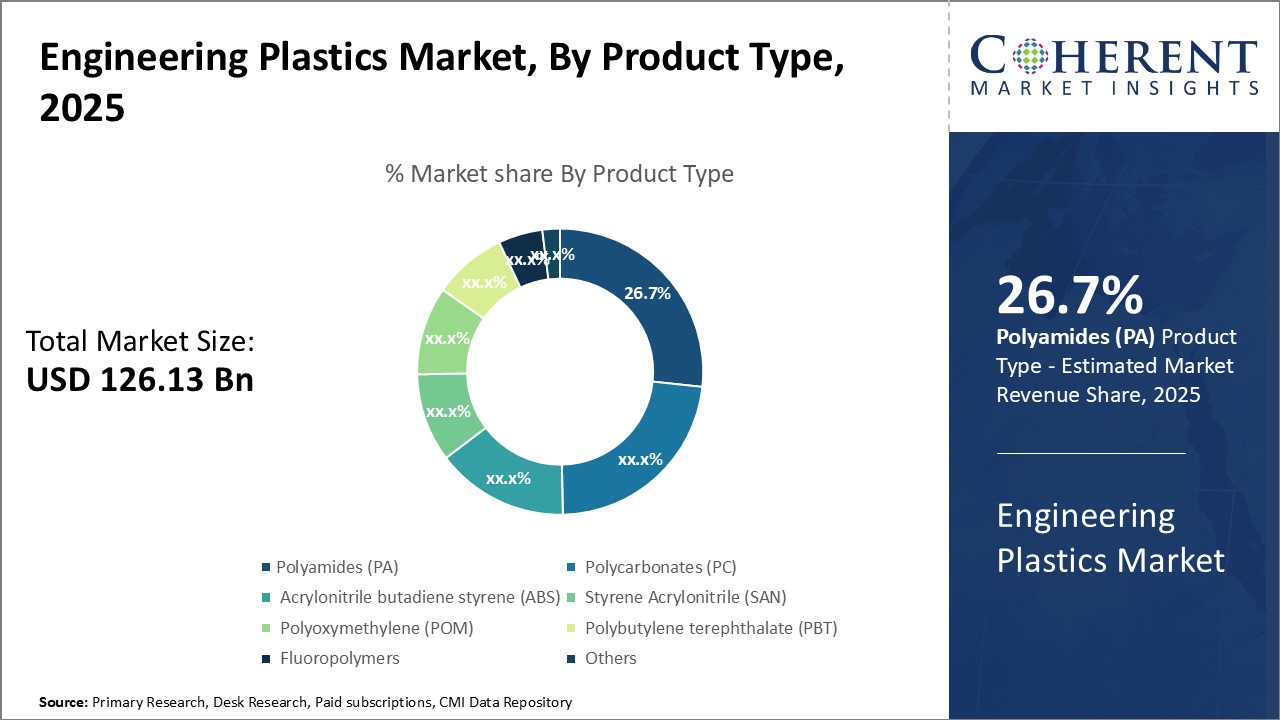Global engineering plastics market is estimated to be valued at USD 126.13 Bn in 2025 and is expected to reach USD 186.06 Bn by 2032, exhibiting a compound annual growth rate (CAGR) of 5.7% from 2025 to 2032.

Discover market dynamics shaping the industry: Request sample copy
Rising adoption of engineering plastics across automotive, electronics, and construction industries due to beneficial properties such as lightweight, durability and resistance to heat and corrosion can drive the market growth. Rapid urbanization and growth in developed economies coupled with infrastructure development projects can boost consumption of engineering plastics. The stringent regulations regarding fuel efficiency and emission control can boost adoption of lightweight materials like engineering plastics in automotive industry. However, availability of substitutes at lower costs can hamper the market growth.
Growing Demand from the Automotive Industry
The automotive industry is always at the forefront of adopting new materials to reduce weight and improve fuel efficiency of vehicles. Engineering plastics are increasingly becoming materials of choice for various auto components due to their high strength-to-weight ratio as compared to metals. As regulations around the world become stricter for automakers to achieve certain mileage targets and reduce emissions, there is a renewed focus on substituting heavier metal parts with lightweight plastics. Engineering thermoplastics like polycarbonate, polyamide, acrylonitrile butadiene styrene, and polyoxymethylene allow automakers to shed valuable pounds from an average car that helps in fuel consumption. Engineering plastics provide designers greater flexibility to optimize part performance. For example, polyamides are finding more applications in under-the-hood components like air intake manifolds and fluid connector assemblies because of their fuel and oil resistance combined with fatigue and impact resistance. On the body exterior, polycarbonate usage is growing for applications ranging from daytime running lamp covers to side view mirror housing. These parts previously used coated metals but plastics reduce not just weight but part complexity and assembly costs. As automotive technology becomes more advanced with trends like hybrid and electric vehicles gaining traction, there has been huge demand for high performance plastics from auto OEMs and their suppliers in the near future.

Get actionable strategies to beat competition: Request sample copy
Usage in Consumer Electronics and AppliancesGrowing consumer products industry can drive the market growth. Nowadays consumer expects high-tech devices and appliances that are lightweight, durable, and packed with features. This pushes OEMs to utilize materials like polycarbonate, polyamide, acrylic, and modified polyphenylene oxide in devices ranging from smartphones, laptops, and TVs to washing machines, refrigerators, and blenders. Engineering thermoplastics allow thinner and more compact designs without compromising on strength. Forexample, , polycarbonate is the material of choice for parts like phone casings, tablet covers, and appliance exterior panels due to its impact resistance and ability to be molded into complex shapes. Polyamides are used as structural components, drawers, and fasteners where their self-lubricating nature prevents wear and tear.
Key Takeaways from Analyst:
Global engineering plastics market is expected to witness growth due to increasing use of plastics in various end-use industries like automotive, electronics, and industrial machinery. Lightweighting initiatives by automakers boosts demand for high-performance plastics thatcan reduce the weight of vehicles and improve fuel efficiency. Regulations on carbon emissions are further driving the market growth.
In the electronics industry, the miniaturization of devices boosts the use of engineered thermoplastics and thermosets that offer properties like heat resistance, dimensional stability, and electrical insulation. These plastics enable manufacturers to develop compact devicesIncreasing investments in renewable energy equipment like wind turbines where engineering plastics are used commonly.
Volatility in raw material prices can pose challenges for the market players. Fluctuations in crude oil prices directly impact plastic resin costs. Stringent environmental norms around plastic disposal can hamper the market growth.
Challenge: High manufacturing cost
The high manufacturing cost of engineering plastics is posing a significant restraint on the growth of the global engineering plastics market. Engineering plastics require sophisticated production processes and environmentally controlled facilities to manufacture. The raw materials used in engineering plastics such as polyamide, polycarbonate, acrylonitrile butadiene styrene, polyacetal, and polyphenylene oxide are polymerized or blended at high temperatures under precise conditions. This makes the manufacturing equipment and tooling highly specialized and capital intensive. Maintaining stringent quality standards further drives up the production costs. The costs of setting up and operating such manufacturing units are prohibitive for small and mid-sized plastic product manufacturers. It involves huge capital investments for advanced plants and machinery. There are also significant operating expenses towards utilities like electricity and fuel to maintain the temperature and pressure levels during polymerization and blending of raw materials. Highly skilled workforce is needed to monitor and operate the complex manufacturing systems which increases the labor costs. Additional expenditures are incurred for pollution control and waste treatment as many engineering plastic production processes generate hazardous byproducts. Regulatory compliance with environment and safety standards in different regions also impacts the expense of manufacturing.
Opportunity: Developments of bio-based engineering plastics
The growth of the global engineering plastics market faces a major restraint owing to the developments taking place in the field of bio-based engineering plastics. As environmental concerns rise globally and plastics disposal becomes a challenge, the industry is exploring more sustainable alternatives. This is where bio-based engineering plastics have found major traction in recent years. Bio-based plastics are derived from renewable biomass sources such as sugarcane, corn starch, vegetable fats and oils, rather than petroleum. They help reduce dependence on fossil fuels and make the production process more eco-friendly. Several variants of bio-polyesters, bio-polyamides and PHA (polyhydroxyalkanoate) based plastics have been developed which exhibit properties comparable to traditional engineering thermoplastics. Major automotive and consumer goods manufacturers have started adopting these sustainable biomaterials for various components. For example, Ford Motor Company launched an initiative in 2020 to incorporate recycled and bio-based materials in vehicles to reduce environmental impact.

Discover high revenue pocket segments and roadmap to it: Request sample copy
Insights, By Product Type : Acrylonitrile Butadiene Styrene's Versatility Drives its DominanceAmong product type, acrylonitrile butadiene styrene(ABS) segment is estimated to contribute the 26.7% share of the engineering plastics market in 2025, due to its properties . ABS can be molded into a wide variety of complex shapes while maintaining excellent durability and dimensional stability. It also offers strength and impact resistance comparable to polycarbonate but at a lower cost. ABS's versatile properties makes it well-suited for a diverse range of applications. In the automotive industry, ABS is widely used in interior and exterior body panels as it can withstand high temperatures without warping or fading. Its strength allows for lightweight yet rigid bumpers that enhance fuel efficiency. ABS is also utilized in electrical/electronic products due to its ability to be flame retardant, which is a crucial safety requirement. It shepherds ABS's dominance in housings for laptops, power tools, and small appliances. ABS's ease of processing further increases its appeal. It has high melt flow characteristics, allowing for rapid injection molding cycle times. Complex geometries with tight tolerances can be molded easily and economically at high production rates. ABS also has good layer bonding in multilayer molding. These processing benefits translate to lower per-unit costs, providing ABS an advantage over price-sensitive commodity products. ABS's aesthetic properties have catalyzed its use in a variety of decorative applications. It has an attractive glossy surface and comes in a wide array of vivid, saturated colors. This has made ABS the plastic of choice for items like consumer electronics casings, architectural trims, and commercial signs. ABS 's exceptional blend of mechanical performance, low cost, and visual appeal cements its lead position among engineering plastics.
Insights, By Applications: Electrical and Electronics leads due to miniaturization and performance demand
Among applications, electrical and electronics segment is estimated to contribute 36.1% share of the market in 2025, due to the miniaturization and performance needs of modern devices. Engineering plastics help meet the stringent requirements of electronics including heat resistance, high strength-to-weight ratios, electrical insulation, flame retardance, and resistance to chemical attacks and moisture. ABS and polycarbonate are extensively used in electronics devices due to their balance of mechanical and electrical properties. Acrylic is commonly utilized for components requiring optical clarity like device screens and windows. Liquid crystal polymers find application in high-frequency applications owing to their low dielectric constants. Performance demands are also growing due to rapid technological advances. Engineering plastics enable the manufacturing of thinner, lighter, and more power-packed devices. For example, polyphenylene sulfide allows for more compact circuit boards through fine-line traces and high-density packaging. Liquid crystal polymers facilitate faster data processing as these exhibit minimal signal loss even at microwave frequencies. Progress in miniaturization contributes significantly to the volume growth as electronics continue to infiltrate new product categories. Engineering plastics are indispensable partners in this process by facilitating the manufacturing of smaller, smarter, and more feature-rich devices. Their specialized material properties fulfill the stringent needs of next-gen technologies like 5G networks, artificial intelligence, and the Internet of Things.

Need a Different Region or Segment? Customize now
North America has established itself as the dominant region in the global engineering plastics market with estimated 39.9% share in 2025. The U.S. has a strong manufacturing base with leading industries such as automotive, aerospace, electronics and healthcare. This industrial presence supports high demand for engineering plastics within the region. Major automakers and aerospace manufacturers rely on durable and lightweight plastic components to improve product performance and meet stringent regulatory requirements. North American plastic converters also have expertise in developing advanced formulations tailored for applications such as under-the-hood automotive parts subjected to high heat. The established supply chain and distribution channels for engineering plastics also drives the market growth in the region. Leading plastic resin producers operate several manufacturing facilities across the U.S. and Canada in order to stabilize supply for North American buyers. Proximity to end users enables timely deliveries and reduces transportation costs. Engineers and product designers in the region are well-versed in utilizing engineering plastics to develop innovative solutions. These can work closely with domestic resin suppliers during the product development stage. These factors combined have ensured North America accounts for the largest share of the global market.
Asia Pacific region is the fatest growing market for engineering plastics. China represents the major growth driver within Asia Pacific due to its giant manufacturing sector and rapidly expanding middle class population. Growing domestic automotive industry combined with plants set up by global automakers boosts consumption of engineering plastics. The shift of electronics production from developed markets to China and other South Asian countries will support plastic demand from the appliances and consumer goods sectors. The presence of large converter bases catering to the needs of multinational corporations gives Asia Pacific economies price competitiveness in manufacturing finished plastic parts. Asia Pacific’s low-cost manufacturing environment and proximity to end-use markets can drive the market growth in the region.
Engineering Plastics Market Report Coverage
| Report Coverage | Details | ||
|---|---|---|---|
| Base Year: | 2024 | Market Size in 2025: | USD 126.13 Bn |
| Historical Data for: | 2020 To 2024 | Forecast Period: | 2025 To 2032 |
| Forecast Period 2025 to 2032 CAGR: | 5.7% | 2032 Value Projection: | USD 186.06 Bn |
| Geographies covered: |
|
||
| Segments covered: |
|
||
| Companies covered: |
Arkema Group, Asahi Kasei Corporation, BASF SE, Celanese Corporation, Covestro, DSM N.V., Dupont, Lanxess, LG Chem., Mitsubishi Engineering-Plastics Corporation, Saudi Basic Industries Corporation (Sabic), Solvay SA, Teijin, Toray, Victrex Plc., Bhansali Engineering Polymers Limited., Chiripal Poly Film., Gujarat Fluorochemicals Limited (GFL), Hindustan Fluorocarbons Limited., INEOS |
||
| Growth Drivers: |
|
||
| Restraints & Challenges: |
|
||
Uncover macros and micros vetted on 75+ parameters: Get instant access to report
*Definition: The engineering plastics market offers high-performance thermoplastic and thermosetting plastic materials that are employed in numerous industries due to their superior properties compared to standard plastics. These plastics exhibit improved mechanical and thermal properties, chemical resistance, and durability, making them suitable for a variety of applications in automotive, aerospace, industrial and medical sectors where performance, safety and reliability are critical.
Share
Share
About Author
Vidyesh Swar is a seasoned Consultant with a diverse background in market research and business consulting. With over 6 years of experience, Vidyesh has established a strong reputation for his proficiency in market estimations, supplier landscape analysis, and market share assessments for tailored research solution. Using his deep industry knowledge and analytical skills, he provides valuable insights and strategic recommendations, enabling clients to make informed decisions and navigate complex business landscapes.
Missing comfort of reading report in your local language? Find your preferred language :
Transform your Strategy with Exclusive Trending Reports :
Frequently Asked Questions
Joining thousands of companies around the world committed to making the Excellent Business Solutions.
View All Our Clients
US Reciprocal Tax Impact Analysis On Engineering Plastics Market
Stay updated on tariff changes with expert insights and timely information